HRM Practices: Application in a Work-Related Context Project
VerifiedAdded on 2024/05/29
|15
|4580
|432
Project
AI Summary
This project provides a comprehensive overview of Human Resource Management (HRM), focusing on its purpose, scope, and key functions in resourcing an organization with talent and skills aligned with business objectives. It examines the strengths and weaknesses of internal and external recruitment approaches, highlighting the importance of job analysis, recruitment, training, and employee relations. The project evaluates the effectiveness of HRM practices in raising organizational profit and productivity, exploring various methods and their applications. Furthermore, it analyzes internal and external factors, including employment legislation, that affect HRM decision-making, emphasizing the significance of employee relations. Finally, the project illustrates the application of HRM practices in a work-related context, providing a rationale for specific HRM strategies and their influence on organizational decision-making. Desklib provides past papers and solved assignments for students.

Human Resources Management
EXTENDED PROJECT
INDIVIDUAL ASSIGNMENT
Word count: 3000
1 | P a g e
EXTENDED PROJECT
INDIVIDUAL ASSIGNMENT
Word count: 3000
1 | P a g e
Paraphrase This Document
Need a fresh take? Get an instant paraphrase of this document with our AI Paraphraser

Table of Contents
LO1 Explain the purpose and scope of Human Resource Management in terms of
resourcing an organisation with talent and skills appropriate to fulfil business objectives3
P1 Explain the purpose and the functions of HRM, applicable to workforce planning
and resourcing an organisation......................................................................................3
P2 Explain the strengths and weaknesses of different approaches to recruitment and
selection.........................................................................................................................4
M1: Identify and explain the HR functions to fulfil business objectives.........................5
M2: Evaluate the strengths and weaknesses approaches to recruitment and selection
........................................................................................................................................6
D1: Critically evaluate the strengths and weaknesses of approaches to recruitment
and selection..................................................................................................................6
LO2 Evaluate the effectiveness of the key elements of Human Resource Management
in an organization..............................................................................................................8
P3 Explain the benefits of different HRM practices within an organisation for both the
employer and employee.................................................................................................8
P4 Evaluate the effectiveness of different HRM practices in terms of raising
organisational profit and productivity..............................................................................9
M3: Explore different methods used in HRM practices................................................10
D2: Evaluate the HRM practices and their application................................................11
LO3 Analyse internal and external factors that affect Human Resource Management
decision making, including employment legislation.........................................................12
P5 Analyse the importance of employee relations with respect to influencing HRM
decision- making..........................................................................................................12
P6 Identify the key elements of employment legislation and the impact it has on HRM
decision- making...........................................................................................................12
M4: Identify the key aspects of employee relations management and employment
legislation......................................................................................................................13
LO4 Apply Human Resource Management practices in a work related context.............14
P7 Illustrate the application of HRM practices in a work related context, using specific
examples......................................................................................................................14
M5: Provide a rationale for the application of specific HRM........................................14
D3: Critically evaluate employee relations and the application of HRM practices that
inform and influence decision-making in an organisational context............................14
References.......................................................................................................................15
2 | P a g e
LO1 Explain the purpose and scope of Human Resource Management in terms of
resourcing an organisation with talent and skills appropriate to fulfil business objectives3
P1 Explain the purpose and the functions of HRM, applicable to workforce planning
and resourcing an organisation......................................................................................3
P2 Explain the strengths and weaknesses of different approaches to recruitment and
selection.........................................................................................................................4
M1: Identify and explain the HR functions to fulfil business objectives.........................5
M2: Evaluate the strengths and weaknesses approaches to recruitment and selection
........................................................................................................................................6
D1: Critically evaluate the strengths and weaknesses of approaches to recruitment
and selection..................................................................................................................6
LO2 Evaluate the effectiveness of the key elements of Human Resource Management
in an organization..............................................................................................................8
P3 Explain the benefits of different HRM practices within an organisation for both the
employer and employee.................................................................................................8
P4 Evaluate the effectiveness of different HRM practices in terms of raising
organisational profit and productivity..............................................................................9
M3: Explore different methods used in HRM practices................................................10
D2: Evaluate the HRM practices and their application................................................11
LO3 Analyse internal and external factors that affect Human Resource Management
decision making, including employment legislation.........................................................12
P5 Analyse the importance of employee relations with respect to influencing HRM
decision- making..........................................................................................................12
P6 Identify the key elements of employment legislation and the impact it has on HRM
decision- making...........................................................................................................12
M4: Identify the key aspects of employee relations management and employment
legislation......................................................................................................................13
LO4 Apply Human Resource Management practices in a work related context.............14
P7 Illustrate the application of HRM practices in a work related context, using specific
examples......................................................................................................................14
M5: Provide a rationale for the application of specific HRM........................................14
D3: Critically evaluate employee relations and the application of HRM practices that
inform and influence decision-making in an organisational context............................14
References.......................................................................................................................15
2 | P a g e
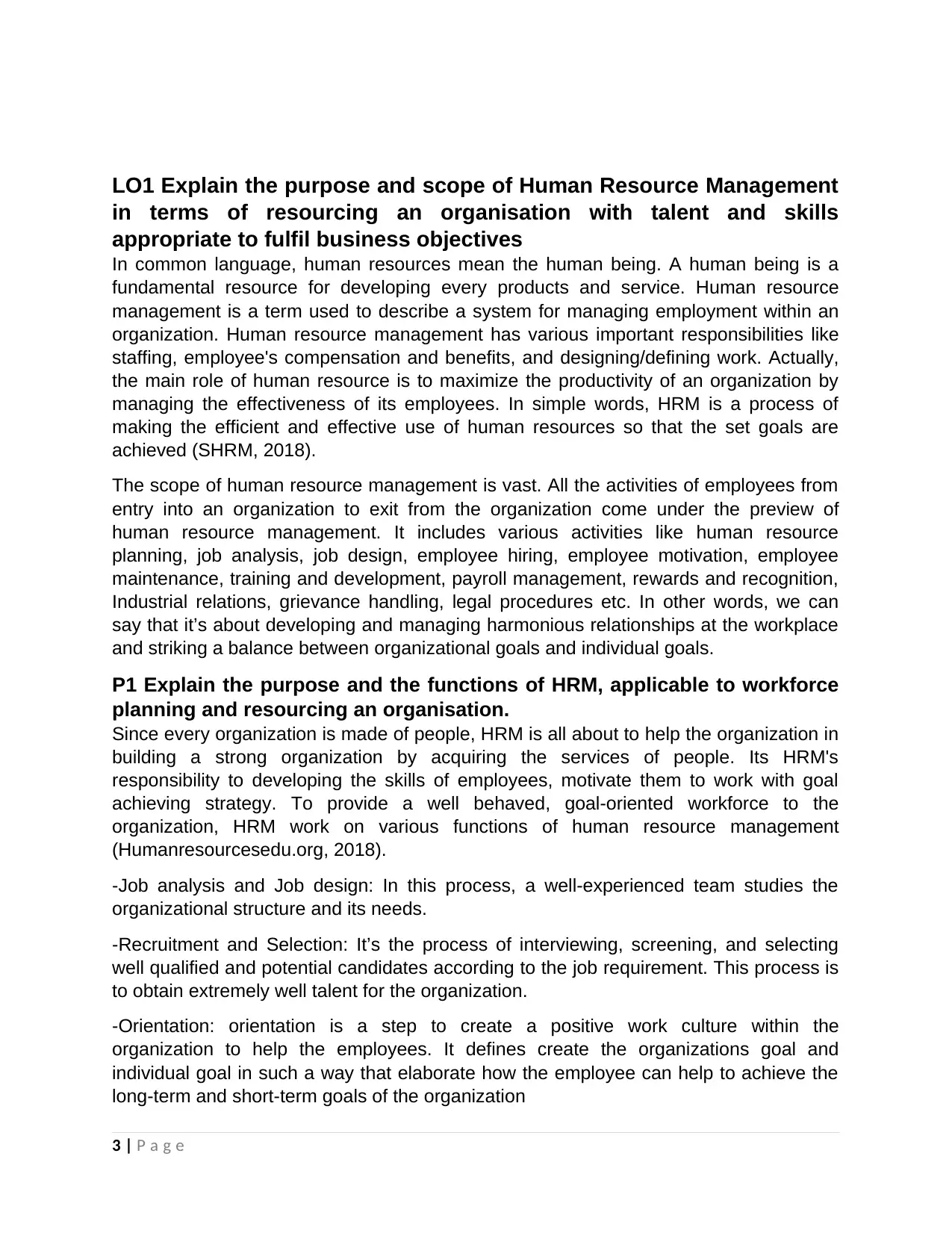
LO1 Explain the purpose and scope of Human Resource Management
in terms of resourcing an organisation with talent and skills
appropriate to fulfil business objectives
In common language, human resources mean the human being. A human being is a
fundamental resource for developing every products and service. Human resource
management is a term used to describe a system for managing employment within an
organization. Human resource management has various important responsibilities like
staffing, employee's compensation and benefits, and designing/defining work. Actually,
the main role of human resource is to maximize the productivity of an organization by
managing the effectiveness of its employees. In simple words, HRM is a process of
making the efficient and effective use of human resources so that the set goals are
achieved (SHRM, 2018).
The scope of human resource management is vast. All the activities of employees from
entry into an organization to exit from the organization come under the preview of
human resource management. It includes various activities like human resource
planning, job analysis, job design, employee hiring, employee motivation, employee
maintenance, training and development, payroll management, rewards and recognition,
Industrial relations, grievance handling, legal procedures etc. In other words, we can
say that it’s about developing and managing harmonious relationships at the workplace
and striking a balance between organizational goals and individual goals.
P1 Explain the purpose and the functions of HRM, applicable to workforce
planning and resourcing an organisation.
Since every organization is made of people, HRM is all about to help the organization in
building a strong organization by acquiring the services of people. Its HRM's
responsibility to developing the skills of employees, motivate them to work with goal
achieving strategy. To provide a well behaved, goal-oriented workforce to the
organization, HRM work on various functions of human resource management
(Humanresourcesedu.org, 2018).
-Job analysis and Job design: In this process, a well-experienced team studies the
organizational structure and its needs.
-Recruitment and Selection: It’s the process of interviewing, screening, and selecting
well qualified and potential candidates according to the job requirement. This process is
to obtain extremely well talent for the organization.
-Orientation: orientation is a step to create a positive work culture within the
organization to help the employees. It defines create the organizations goal and
individual goal in such a way that elaborate how the employee can help to achieve the
long-term and short-term goals of the organization
3 | P a g e
in terms of resourcing an organisation with talent and skills
appropriate to fulfil business objectives
In common language, human resources mean the human being. A human being is a
fundamental resource for developing every products and service. Human resource
management is a term used to describe a system for managing employment within an
organization. Human resource management has various important responsibilities like
staffing, employee's compensation and benefits, and designing/defining work. Actually,
the main role of human resource is to maximize the productivity of an organization by
managing the effectiveness of its employees. In simple words, HRM is a process of
making the efficient and effective use of human resources so that the set goals are
achieved (SHRM, 2018).
The scope of human resource management is vast. All the activities of employees from
entry into an organization to exit from the organization come under the preview of
human resource management. It includes various activities like human resource
planning, job analysis, job design, employee hiring, employee motivation, employee
maintenance, training and development, payroll management, rewards and recognition,
Industrial relations, grievance handling, legal procedures etc. In other words, we can
say that it’s about developing and managing harmonious relationships at the workplace
and striking a balance between organizational goals and individual goals.
P1 Explain the purpose and the functions of HRM, applicable to workforce
planning and resourcing an organisation.
Since every organization is made of people, HRM is all about to help the organization in
building a strong organization by acquiring the services of people. Its HRM's
responsibility to developing the skills of employees, motivate them to work with goal
achieving strategy. To provide a well behaved, goal-oriented workforce to the
organization, HRM work on various functions of human resource management
(Humanresourcesedu.org, 2018).
-Job analysis and Job design: In this process, a well-experienced team studies the
organizational structure and its needs.
-Recruitment and Selection: It’s the process of interviewing, screening, and selecting
well qualified and potential candidates according to the job requirement. This process is
to obtain extremely well talent for the organization.
-Orientation: orientation is a step to create a positive work culture within the
organization to help the employees. It defines create the organizations goal and
individual goal in such a way that elaborate how the employee can help to achieve the
long-term and short-term goals of the organization
3 | P a g e
⊘ This is a preview!⊘
Do you want full access?
Subscribe today to unlock all pages.

Trusted by 1+ million students worldwide
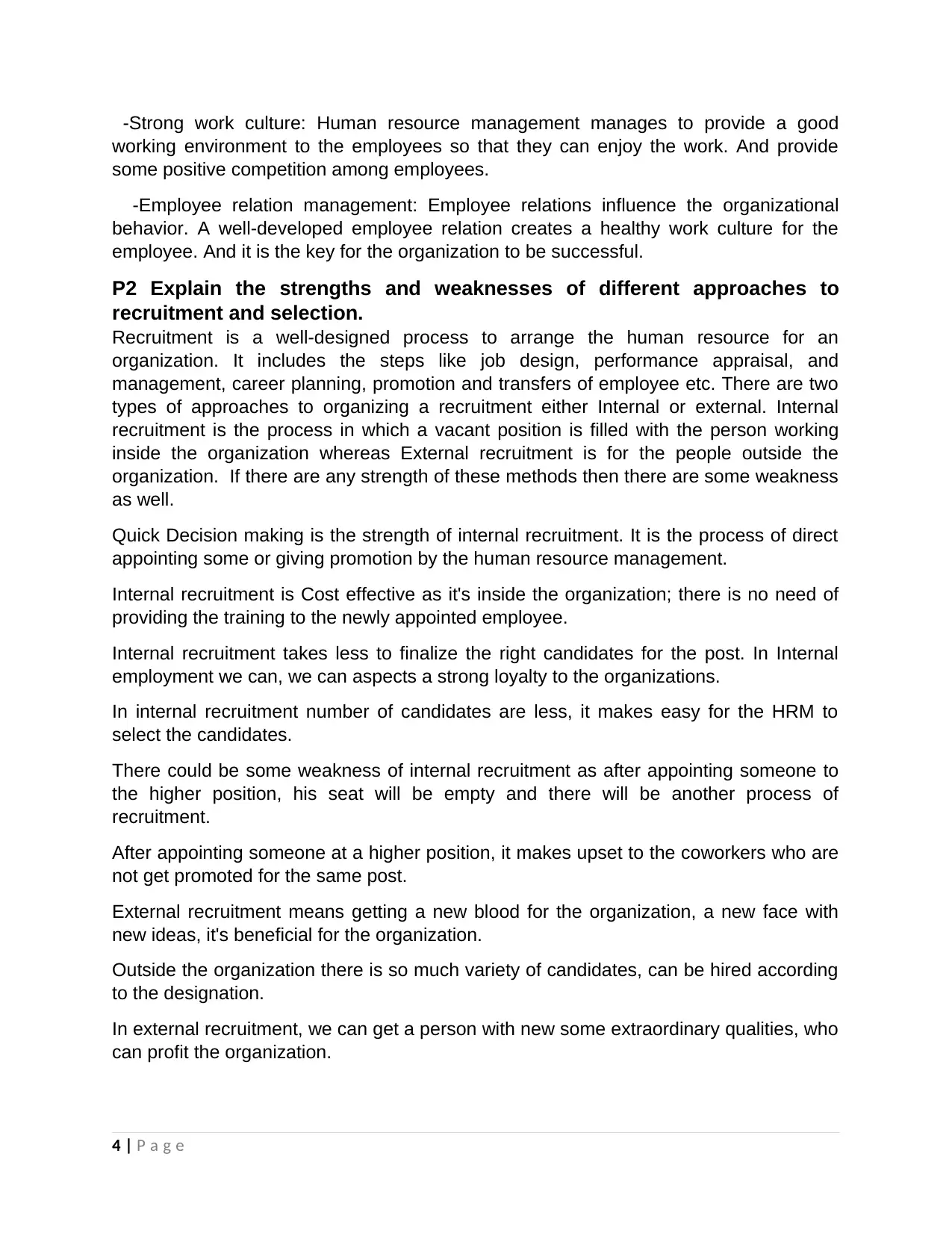
-Strong work culture: Human resource management manages to provide a good
working environment to the employees so that they can enjoy the work. And provide
some positive competition among employees.
-Employee relation management: Employee relations influence the organizational
behavior. A well-developed employee relation creates a healthy work culture for the
employee. And it is the key for the organization to be successful.
P2 Explain the strengths and weaknesses of different approaches to
recruitment and selection.
Recruitment is a well-designed process to arrange the human resource for an
organization. It includes the steps like job design, performance appraisal, and
management, career planning, promotion and transfers of employee etc. There are two
types of approaches to organizing a recruitment either Internal or external. Internal
recruitment is the process in which a vacant position is filled with the person working
inside the organization whereas External recruitment is for the people outside the
organization. If there are any strength of these methods then there are some weakness
as well.
Quick Decision making is the strength of internal recruitment. It is the process of direct
appointing some or giving promotion by the human resource management.
Internal recruitment is Cost effective as it's inside the organization; there is no need of
providing the training to the newly appointed employee.
Internal recruitment takes less to finalize the right candidates for the post. In Internal
employment we can, we can aspects a strong loyalty to the organizations.
In internal recruitment number of candidates are less, it makes easy for the HRM to
select the candidates.
There could be some weakness of internal recruitment as after appointing someone to
the higher position, his seat will be empty and there will be another process of
recruitment.
After appointing someone at a higher position, it makes upset to the coworkers who are
not get promoted for the same post.
External recruitment means getting a new blood for the organization, a new face with
new ideas, it's beneficial for the organization.
Outside the organization there is so much variety of candidates, can be hired according
to the designation.
In external recruitment, we can get a person with new some extraordinary qualities, who
can profit the organization.
4 | P a g e
working environment to the employees so that they can enjoy the work. And provide
some positive competition among employees.
-Employee relation management: Employee relations influence the organizational
behavior. A well-developed employee relation creates a healthy work culture for the
employee. And it is the key for the organization to be successful.
P2 Explain the strengths and weaknesses of different approaches to
recruitment and selection.
Recruitment is a well-designed process to arrange the human resource for an
organization. It includes the steps like job design, performance appraisal, and
management, career planning, promotion and transfers of employee etc. There are two
types of approaches to organizing a recruitment either Internal or external. Internal
recruitment is the process in which a vacant position is filled with the person working
inside the organization whereas External recruitment is for the people outside the
organization. If there are any strength of these methods then there are some weakness
as well.
Quick Decision making is the strength of internal recruitment. It is the process of direct
appointing some or giving promotion by the human resource management.
Internal recruitment is Cost effective as it's inside the organization; there is no need of
providing the training to the newly appointed employee.
Internal recruitment takes less to finalize the right candidates for the post. In Internal
employment we can, we can aspects a strong loyalty to the organizations.
In internal recruitment number of candidates are less, it makes easy for the HRM to
select the candidates.
There could be some weakness of internal recruitment as after appointing someone to
the higher position, his seat will be empty and there will be another process of
recruitment.
After appointing someone at a higher position, it makes upset to the coworkers who are
not get promoted for the same post.
External recruitment means getting a new blood for the organization, a new face with
new ideas, it's beneficial for the organization.
Outside the organization there is so much variety of candidates, can be hired according
to the designation.
In external recruitment, we can get a person with new some extraordinary qualities, who
can profit the organization.
4 | P a g e
Paraphrase This Document
Need a fresh take? Get an instant paraphrase of this document with our AI Paraphraser

External recruitment is a lengthy process; it takes a lot of time and efforts from the
HRM. HRM has to handle all the participated candidates in the selection process. HRM
needs to publish advertising for the external recruitment that consumes so much time.
In the external process, candidates already working feel unsafe and think that they are
not given an opportunity. And this process can affect the quality of the work of
employees already working in an organization.
M1: Identify and explain the HR functions to fulfil business objectives.
Operative Functions
Recruitment: Recruitment is a most challenging process; it requires so much research
about the candidates and job description. It needs a right person for right designation
with enough knowledge.
Training and Development: after selecting the candidate, providing job training is the
responsibility of the HR department. This function makes the employees understand the
process of working and makes it easy for them to get on their jobs with much ease.
Professional Development: It is an important function that provides the employee an
opportunity for growth by brushing their skills by organizing training seminars and
function.
Compensation and Benefits: Employees work better if there are some rewards and
awards. People put their effort for rewards, which makes easier to get the target on right
time. Human resource management should provide the facilities like Working hour
flexibility, timely vacation, Medical Insurance, house and transport expenditures.
Performance Appraisal: The employees of any organization will be evaluated by the HR
department as per the performance. This function helps the organization to get the
employee they have hired is moving towards the goals and objectives of the
organization or not. In this function, it is easy to get the new area of improvement.
Managerial Functions
Planning: This function is very vital to set goals and objectives of an organization. In this
function policies and procedures are prepared to achieve organizational goal.
Organizing: This function is to develop and design the structure of the organization to
get a number of employees, designations, and their work process. All the functions of
an organization can be distrusted in respective people.
Directing: It is a function of HRM to direct the employees in such a way, by which they
get inspiration and try hard to achieve their goals. In this process, managers try to find
the employees need and award them with same to motivate them towards the work.
5 | P a g e
HRM. HRM has to handle all the participated candidates in the selection process. HRM
needs to publish advertising for the external recruitment that consumes so much time.
In the external process, candidates already working feel unsafe and think that they are
not given an opportunity. And this process can affect the quality of the work of
employees already working in an organization.
M1: Identify and explain the HR functions to fulfil business objectives.
Operative Functions
Recruitment: Recruitment is a most challenging process; it requires so much research
about the candidates and job description. It needs a right person for right designation
with enough knowledge.
Training and Development: after selecting the candidate, providing job training is the
responsibility of the HR department. This function makes the employees understand the
process of working and makes it easy for them to get on their jobs with much ease.
Professional Development: It is an important function that provides the employee an
opportunity for growth by brushing their skills by organizing training seminars and
function.
Compensation and Benefits: Employees work better if there are some rewards and
awards. People put their effort for rewards, which makes easier to get the target on right
time. Human resource management should provide the facilities like Working hour
flexibility, timely vacation, Medical Insurance, house and transport expenditures.
Performance Appraisal: The employees of any organization will be evaluated by the HR
department as per the performance. This function helps the organization to get the
employee they have hired is moving towards the goals and objectives of the
organization or not. In this function, it is easy to get the new area of improvement.
Managerial Functions
Planning: This function is very vital to set goals and objectives of an organization. In this
function policies and procedures are prepared to achieve organizational goal.
Organizing: This function is to develop and design the structure of the organization to
get a number of employees, designations, and their work process. All the functions of
an organization can be distrusted in respective people.
Directing: It is a function of HRM to direct the employees in such a way, by which they
get inspiration and try hard to achieve their goals. In this process, managers try to find
the employees need and award them with same to motivate them towards the work.
5 | P a g e
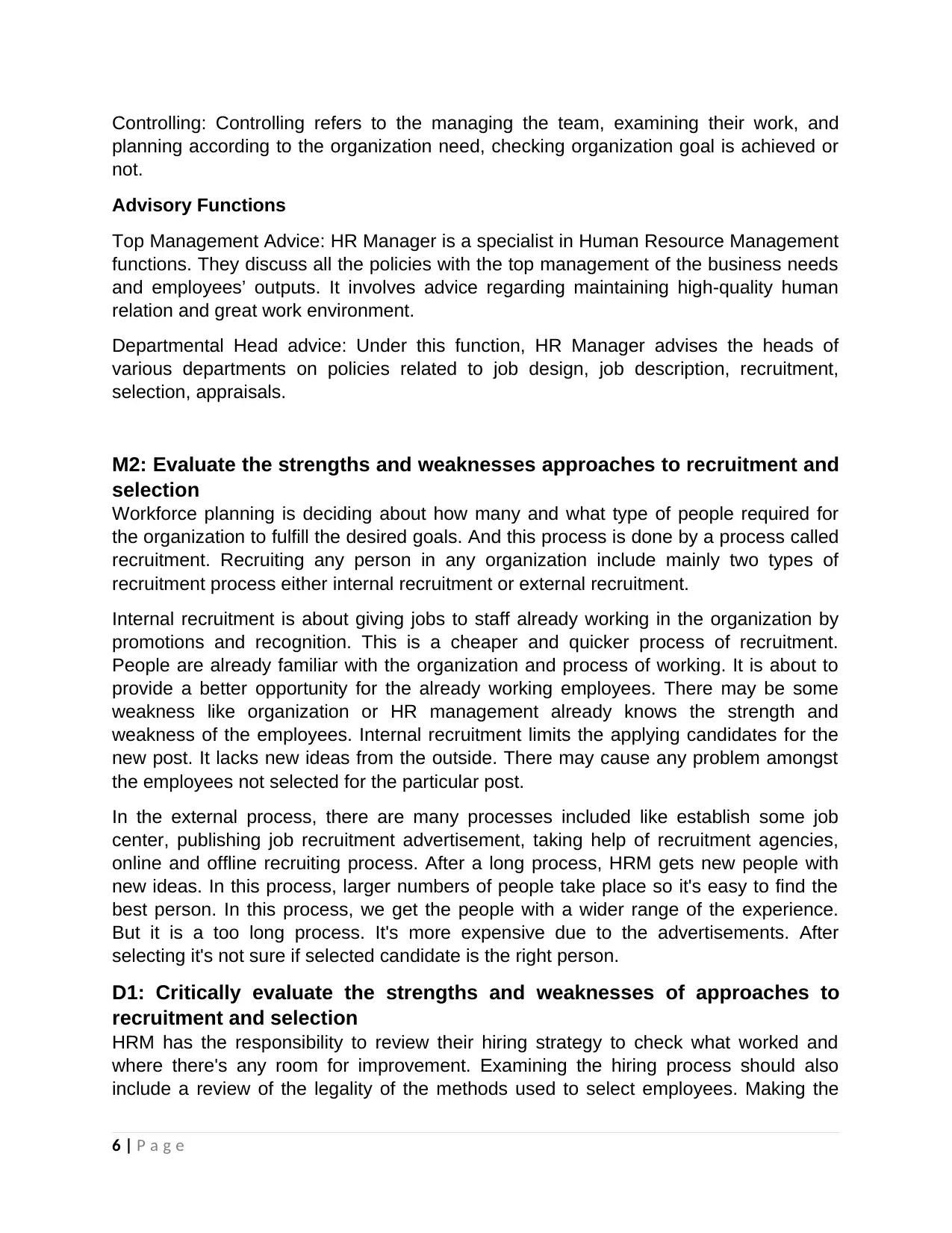
Controlling: Controlling refers to the managing the team, examining their work, and
planning according to the organization need, checking organization goal is achieved or
not.
Advisory Functions
Top Management Advice: HR Manager is a specialist in Human Resource Management
functions. They discuss all the policies with the top management of the business needs
and employees’ outputs. It involves advice regarding maintaining high-quality human
relation and great work environment.
Departmental Head advice: Under this function, HR Manager advises the heads of
various departments on policies related to job design, job description, recruitment,
selection, appraisals.
M2: Evaluate the strengths and weaknesses approaches to recruitment and
selection
Workforce planning is deciding about how many and what type of people required for
the organization to fulfill the desired goals. And this process is done by a process called
recruitment. Recruiting any person in any organization include mainly two types of
recruitment process either internal recruitment or external recruitment.
Internal recruitment is about giving jobs to staff already working in the organization by
promotions and recognition. This is a cheaper and quicker process of recruitment.
People are already familiar with the organization and process of working. It is about to
provide a better opportunity for the already working employees. There may be some
weakness like organization or HR management already knows the strength and
weakness of the employees. Internal recruitment limits the applying candidates for the
new post. It lacks new ideas from the outside. There may cause any problem amongst
the employees not selected for the particular post.
In the external process, there are many processes included like establish some job
center, publishing job recruitment advertisement, taking help of recruitment agencies,
online and offline recruiting process. After a long process, HRM gets new people with
new ideas. In this process, larger numbers of people take place so it's easy to find the
best person. In this process, we get the people with a wider range of the experience.
But it is a too long process. It's more expensive due to the advertisements. After
selecting it's not sure if selected candidate is the right person.
D1: Critically evaluate the strengths and weaknesses of approaches to
recruitment and selection
HRM has the responsibility to review their hiring strategy to check what worked and
where there's any room for improvement. Examining the hiring process should also
include a review of the legality of the methods used to select employees. Making the
6 | P a g e
planning according to the organization need, checking organization goal is achieved or
not.
Advisory Functions
Top Management Advice: HR Manager is a specialist in Human Resource Management
functions. They discuss all the policies with the top management of the business needs
and employees’ outputs. It involves advice regarding maintaining high-quality human
relation and great work environment.
Departmental Head advice: Under this function, HR Manager advises the heads of
various departments on policies related to job design, job description, recruitment,
selection, appraisals.
M2: Evaluate the strengths and weaknesses approaches to recruitment and
selection
Workforce planning is deciding about how many and what type of people required for
the organization to fulfill the desired goals. And this process is done by a process called
recruitment. Recruiting any person in any organization include mainly two types of
recruitment process either internal recruitment or external recruitment.
Internal recruitment is about giving jobs to staff already working in the organization by
promotions and recognition. This is a cheaper and quicker process of recruitment.
People are already familiar with the organization and process of working. It is about to
provide a better opportunity for the already working employees. There may be some
weakness like organization or HR management already knows the strength and
weakness of the employees. Internal recruitment limits the applying candidates for the
new post. It lacks new ideas from the outside. There may cause any problem amongst
the employees not selected for the particular post.
In the external process, there are many processes included like establish some job
center, publishing job recruitment advertisement, taking help of recruitment agencies,
online and offline recruiting process. After a long process, HRM gets new people with
new ideas. In this process, larger numbers of people take place so it's easy to find the
best person. In this process, we get the people with a wider range of the experience.
But it is a too long process. It's more expensive due to the advertisements. After
selecting it's not sure if selected candidate is the right person.
D1: Critically evaluate the strengths and weaknesses of approaches to
recruitment and selection
HRM has the responsibility to review their hiring strategy to check what worked and
where there's any room for improvement. Examining the hiring process should also
include a review of the legality of the methods used to select employees. Making the
6 | P a g e
⊘ This is a preview!⊘
Do you want full access?
Subscribe today to unlock all pages.

Trusted by 1+ million students worldwide
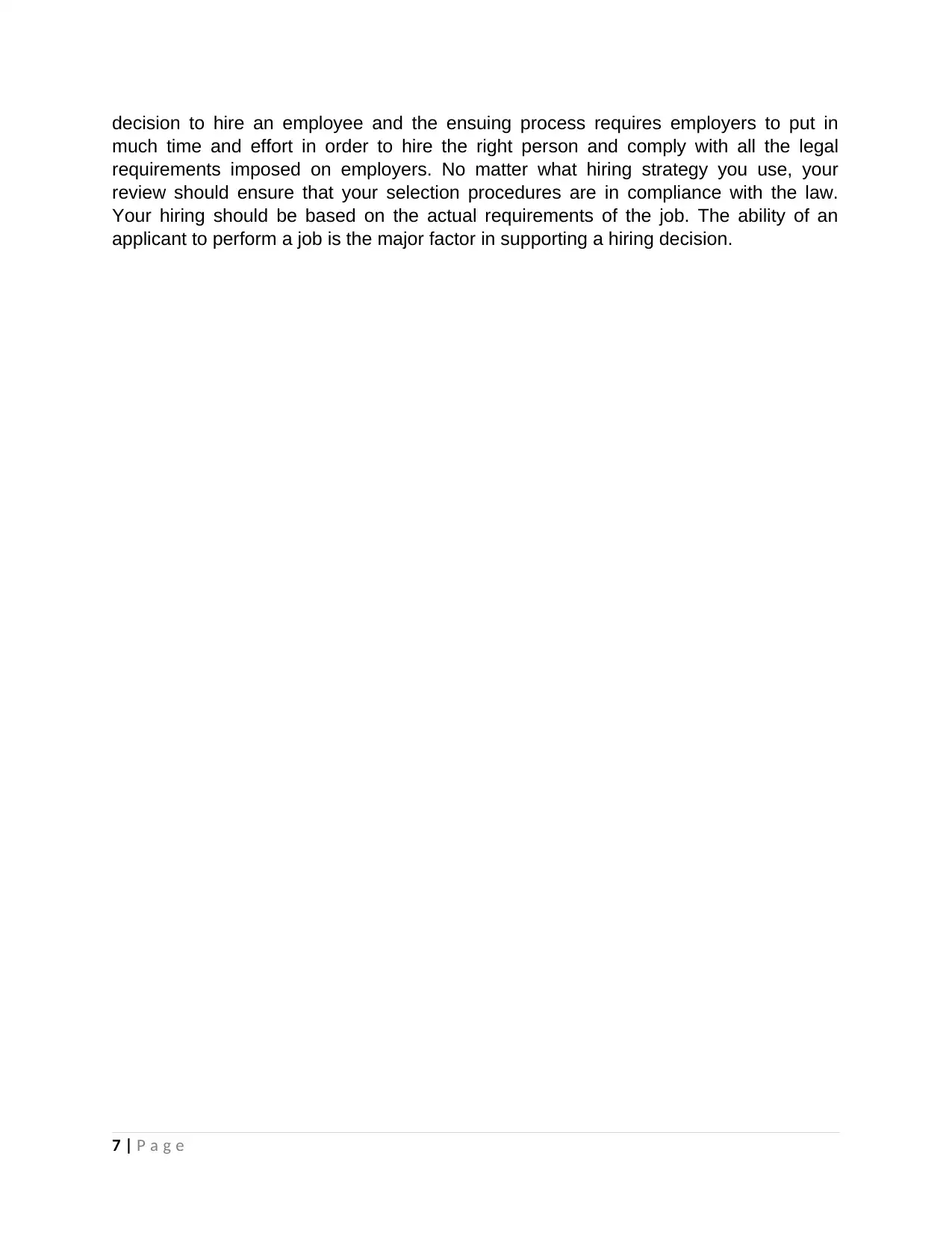
decision to hire an employee and the ensuing process requires employers to put in
much time and effort in order to hire the right person and comply with all the legal
requirements imposed on employers. No matter what hiring strategy you use, your
review should ensure that your selection procedures are in compliance with the law.
Your hiring should be based on the actual requirements of the job. The ability of an
applicant to perform a job is the major factor in supporting a hiring decision.
7 | P a g e
much time and effort in order to hire the right person and comply with all the legal
requirements imposed on employers. No matter what hiring strategy you use, your
review should ensure that your selection procedures are in compliance with the law.
Your hiring should be based on the actual requirements of the job. The ability of an
applicant to perform a job is the major factor in supporting a hiring decision.
7 | P a g e
Paraphrase This Document
Need a fresh take? Get an instant paraphrase of this document with our AI Paraphraser
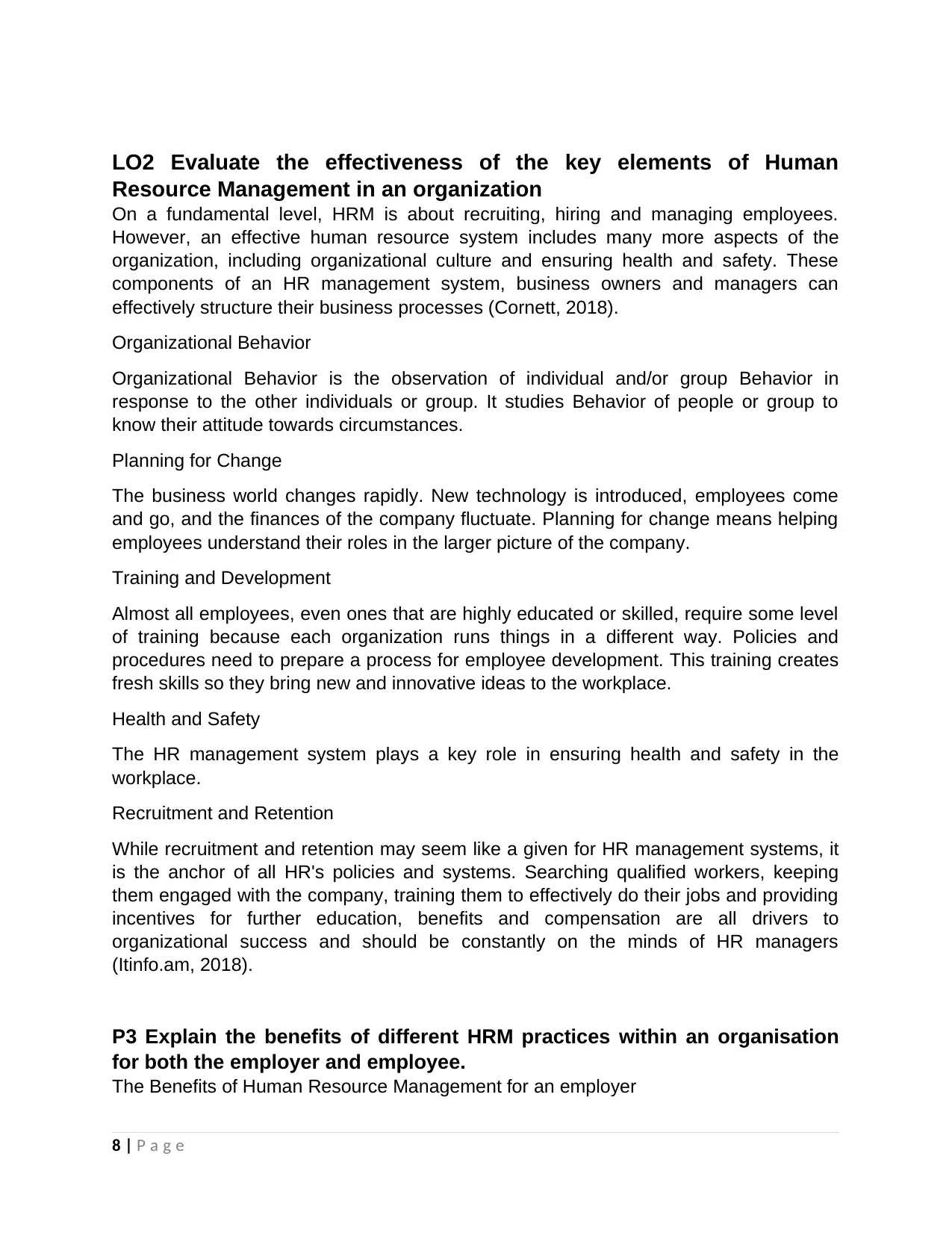
LO2 Evaluate the effectiveness of the key elements of Human
Resource Management in an organization
On a fundamental level, HRM is about recruiting, hiring and managing employees.
However, an effective human resource system includes many more aspects of the
organization, including organizational culture and ensuring health and safety. These
components of an HR management system, business owners and managers can
effectively structure their business processes (Cornett, 2018).
Organizational Behavior
Organizational Behavior is the observation of individual and/or group Behavior in
response to the other individuals or group. It studies Behavior of people or group to
know their attitude towards circumstances.
Planning for Change
The business world changes rapidly. New technology is introduced, employees come
and go, and the finances of the company fluctuate. Planning for change means helping
employees understand their roles in the larger picture of the company.
Training and Development
Almost all employees, even ones that are highly educated or skilled, require some level
of training because each organization runs things in a different way. Policies and
procedures need to prepare a process for employee development. This training creates
fresh skills so they bring new and innovative ideas to the workplace.
Health and Safety
The HR management system plays a key role in ensuring health and safety in the
workplace.
Recruitment and Retention
While recruitment and retention may seem like a given for HR management systems, it
is the anchor of all HR's policies and systems. Searching qualified workers, keeping
them engaged with the company, training them to effectively do their jobs and providing
incentives for further education, benefits and compensation are all drivers to
organizational success and should be constantly on the minds of HR managers
(Itinfo.am, 2018).
P3 Explain the benefits of different HRM practices within an organisation
for both the employer and employee.
The Benefits of Human Resource Management for an employer
8 | P a g e
Resource Management in an organization
On a fundamental level, HRM is about recruiting, hiring and managing employees.
However, an effective human resource system includes many more aspects of the
organization, including organizational culture and ensuring health and safety. These
components of an HR management system, business owners and managers can
effectively structure their business processes (Cornett, 2018).
Organizational Behavior
Organizational Behavior is the observation of individual and/or group Behavior in
response to the other individuals or group. It studies Behavior of people or group to
know their attitude towards circumstances.
Planning for Change
The business world changes rapidly. New technology is introduced, employees come
and go, and the finances of the company fluctuate. Planning for change means helping
employees understand their roles in the larger picture of the company.
Training and Development
Almost all employees, even ones that are highly educated or skilled, require some level
of training because each organization runs things in a different way. Policies and
procedures need to prepare a process for employee development. This training creates
fresh skills so they bring new and innovative ideas to the workplace.
Health and Safety
The HR management system plays a key role in ensuring health and safety in the
workplace.
Recruitment and Retention
While recruitment and retention may seem like a given for HR management systems, it
is the anchor of all HR's policies and systems. Searching qualified workers, keeping
them engaged with the company, training them to effectively do their jobs and providing
incentives for further education, benefits and compensation are all drivers to
organizational success and should be constantly on the minds of HR managers
(Itinfo.am, 2018).
P3 Explain the benefits of different HRM practices within an organisation
for both the employer and employee.
The Benefits of Human Resource Management for an employer
8 | P a g e
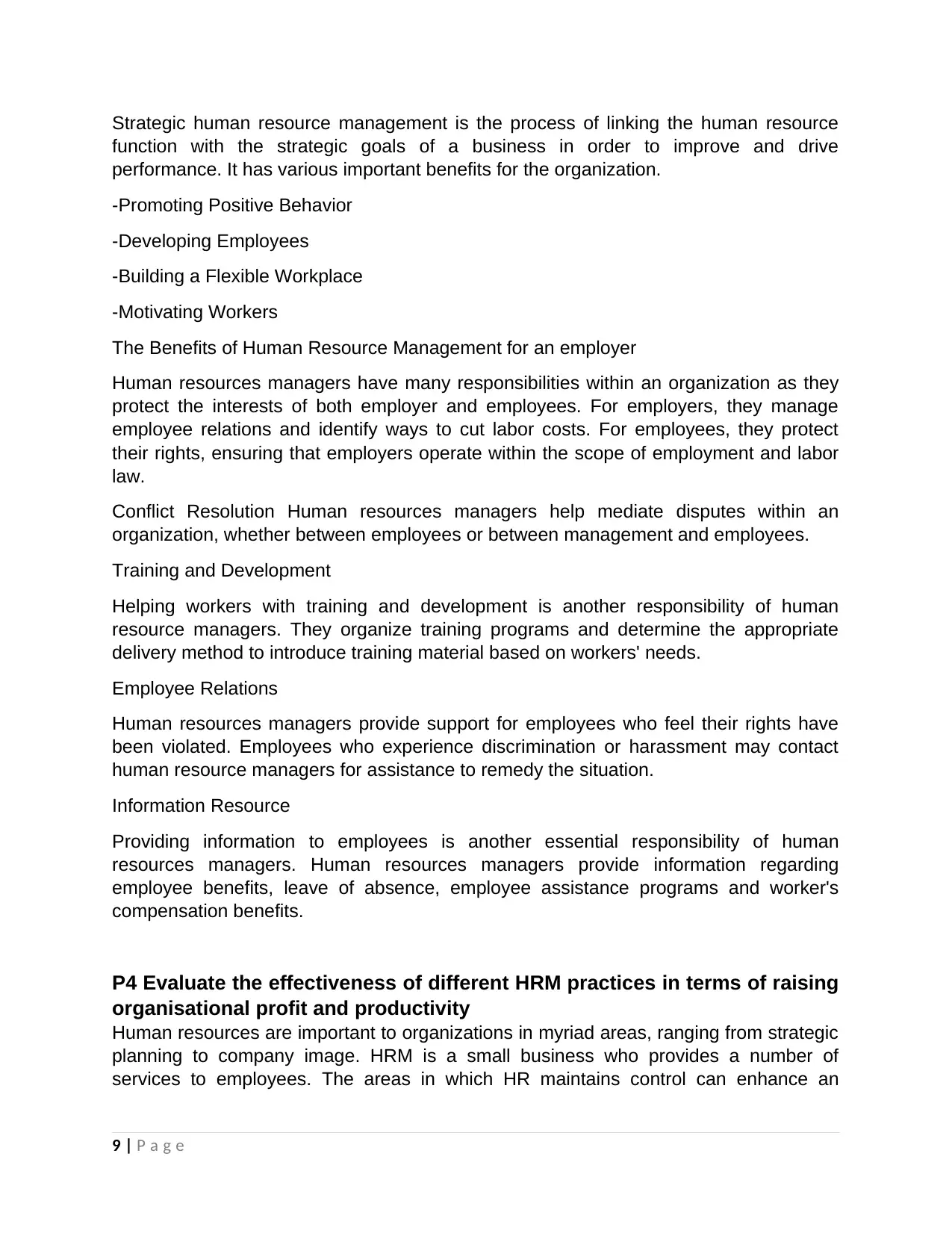
Strategic human resource management is the process of linking the human resource
function with the strategic goals of a business in order to improve and drive
performance. It has various important benefits for the organization.
-Promoting Positive Behavior
-Developing Employees
-Building a Flexible Workplace
-Motivating Workers
The Benefits of Human Resource Management for an employer
Human resources managers have many responsibilities within an organization as they
protect the interests of both employer and employees. For employers, they manage
employee relations and identify ways to cut labor costs. For employees, they protect
their rights, ensuring that employers operate within the scope of employment and labor
law.
Conflict Resolution Human resources managers help mediate disputes within an
organization, whether between employees or between management and employees.
Training and Development
Helping workers with training and development is another responsibility of human
resource managers. They organize training programs and determine the appropriate
delivery method to introduce training material based on workers' needs.
Employee Relations
Human resources managers provide support for employees who feel their rights have
been violated. Employees who experience discrimination or harassment may contact
human resource managers for assistance to remedy the situation.
Information Resource
Providing information to employees is another essential responsibility of human
resources managers. Human resources managers provide information regarding
employee benefits, leave of absence, employee assistance programs and worker's
compensation benefits.
P4 Evaluate the effectiveness of different HRM practices in terms of raising
organisational profit and productivity
Human resources are important to organizations in myriad areas, ranging from strategic
planning to company image. HRM is a small business who provides a number of
services to employees. The areas in which HR maintains control can enhance an
9 | P a g e
function with the strategic goals of a business in order to improve and drive
performance. It has various important benefits for the organization.
-Promoting Positive Behavior
-Developing Employees
-Building a Flexible Workplace
-Motivating Workers
The Benefits of Human Resource Management for an employer
Human resources managers have many responsibilities within an organization as they
protect the interests of both employer and employees. For employers, they manage
employee relations and identify ways to cut labor costs. For employees, they protect
their rights, ensuring that employers operate within the scope of employment and labor
law.
Conflict Resolution Human resources managers help mediate disputes within an
organization, whether between employees or between management and employees.
Training and Development
Helping workers with training and development is another responsibility of human
resource managers. They organize training programs and determine the appropriate
delivery method to introduce training material based on workers' needs.
Employee Relations
Human resources managers provide support for employees who feel their rights have
been violated. Employees who experience discrimination or harassment may contact
human resource managers for assistance to remedy the situation.
Information Resource
Providing information to employees is another essential responsibility of human
resources managers. Human resources managers provide information regarding
employee benefits, leave of absence, employee assistance programs and worker's
compensation benefits.
P4 Evaluate the effectiveness of different HRM practices in terms of raising
organisational profit and productivity
Human resources are important to organizations in myriad areas, ranging from strategic
planning to company image. HRM is a small business who provides a number of
services to employees. The areas in which HR maintains control can enhance an
9 | P a g e
⊘ This is a preview!⊘
Do you want full access?
Subscribe today to unlock all pages.

Trusted by 1+ million students worldwide
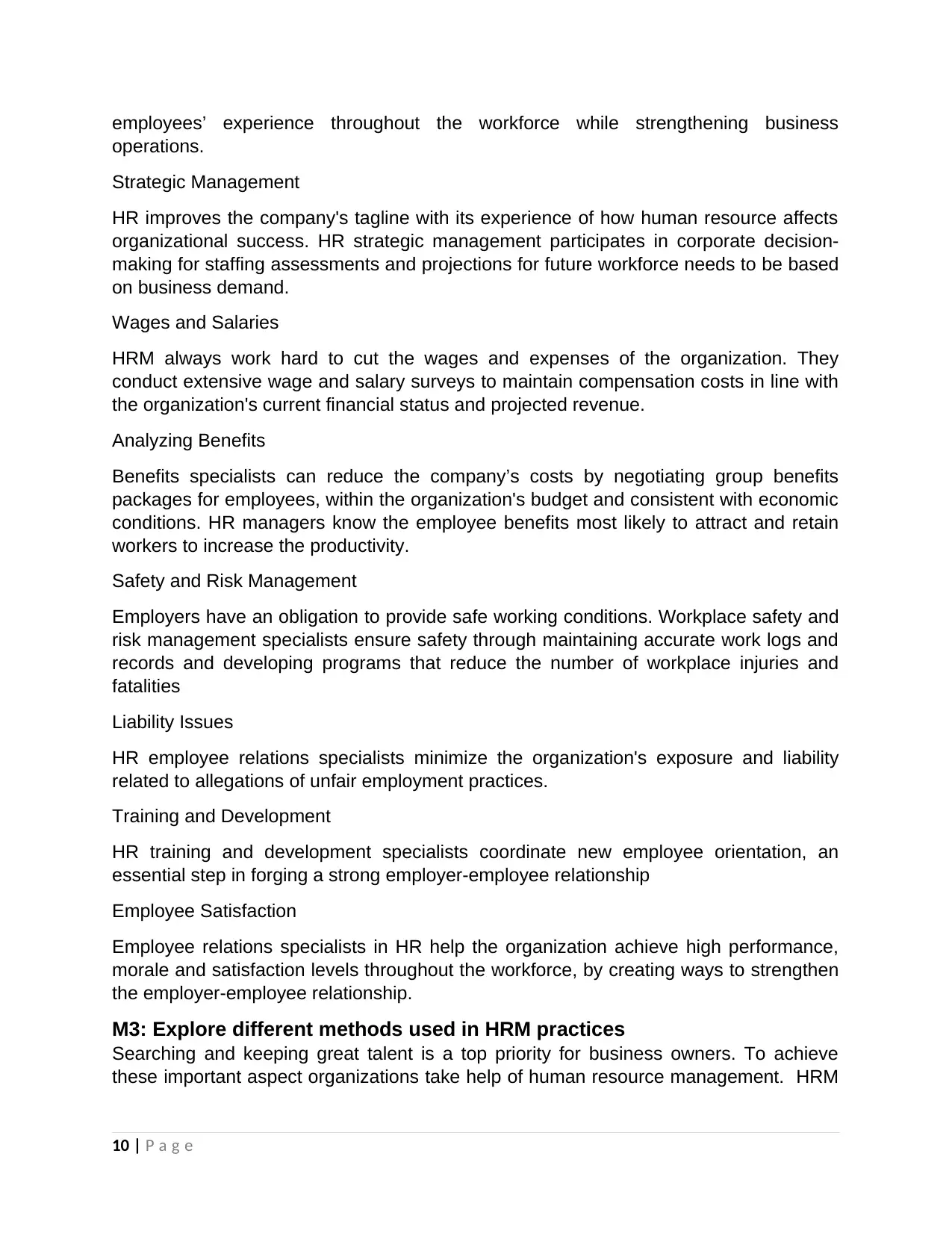
employees’ experience throughout the workforce while strengthening business
operations.
Strategic Management
HR improves the company's tagline with its experience of how human resource affects
organizational success. HR strategic management participates in corporate decision-
making for staffing assessments and projections for future workforce needs to be based
on business demand.
Wages and Salaries
HRM always work hard to cut the wages and expenses of the organization. They
conduct extensive wage and salary surveys to maintain compensation costs in line with
the organization's current financial status and projected revenue.
Analyzing Benefits
Benefits specialists can reduce the company’s costs by negotiating group benefits
packages for employees, within the organization's budget and consistent with economic
conditions. HR managers know the employee benefits most likely to attract and retain
workers to increase the productivity.
Safety and Risk Management
Employers have an obligation to provide safe working conditions. Workplace safety and
risk management specialists ensure safety through maintaining accurate work logs and
records and developing programs that reduce the number of workplace injuries and
fatalities
Liability Issues
HR employee relations specialists minimize the organization's exposure and liability
related to allegations of unfair employment practices.
Training and Development
HR training and development specialists coordinate new employee orientation, an
essential step in forging a strong employer-employee relationship
Employee Satisfaction
Employee relations specialists in HR help the organization achieve high performance,
morale and satisfaction levels throughout the workforce, by creating ways to strengthen
the employer-employee relationship.
M3: Explore different methods used in HRM practices
Searching and keeping great talent is a top priority for business owners. To achieve
these important aspect organizations take help of human resource management. HRM
10 | P a g e
operations.
Strategic Management
HR improves the company's tagline with its experience of how human resource affects
organizational success. HR strategic management participates in corporate decision-
making for staffing assessments and projections for future workforce needs to be based
on business demand.
Wages and Salaries
HRM always work hard to cut the wages and expenses of the organization. They
conduct extensive wage and salary surveys to maintain compensation costs in line with
the organization's current financial status and projected revenue.
Analyzing Benefits
Benefits specialists can reduce the company’s costs by negotiating group benefits
packages for employees, within the organization's budget and consistent with economic
conditions. HR managers know the employee benefits most likely to attract and retain
workers to increase the productivity.
Safety and Risk Management
Employers have an obligation to provide safe working conditions. Workplace safety and
risk management specialists ensure safety through maintaining accurate work logs and
records and developing programs that reduce the number of workplace injuries and
fatalities
Liability Issues
HR employee relations specialists minimize the organization's exposure and liability
related to allegations of unfair employment practices.
Training and Development
HR training and development specialists coordinate new employee orientation, an
essential step in forging a strong employer-employee relationship
Employee Satisfaction
Employee relations specialists in HR help the organization achieve high performance,
morale and satisfaction levels throughout the workforce, by creating ways to strengthen
the employer-employee relationship.
M3: Explore different methods used in HRM practices
Searching and keeping great talent is a top priority for business owners. To achieve
these important aspect organizations take help of human resource management. HRM
10 | P a g e
Paraphrase This Document
Need a fresh take? Get an instant paraphrase of this document with our AI Paraphraser
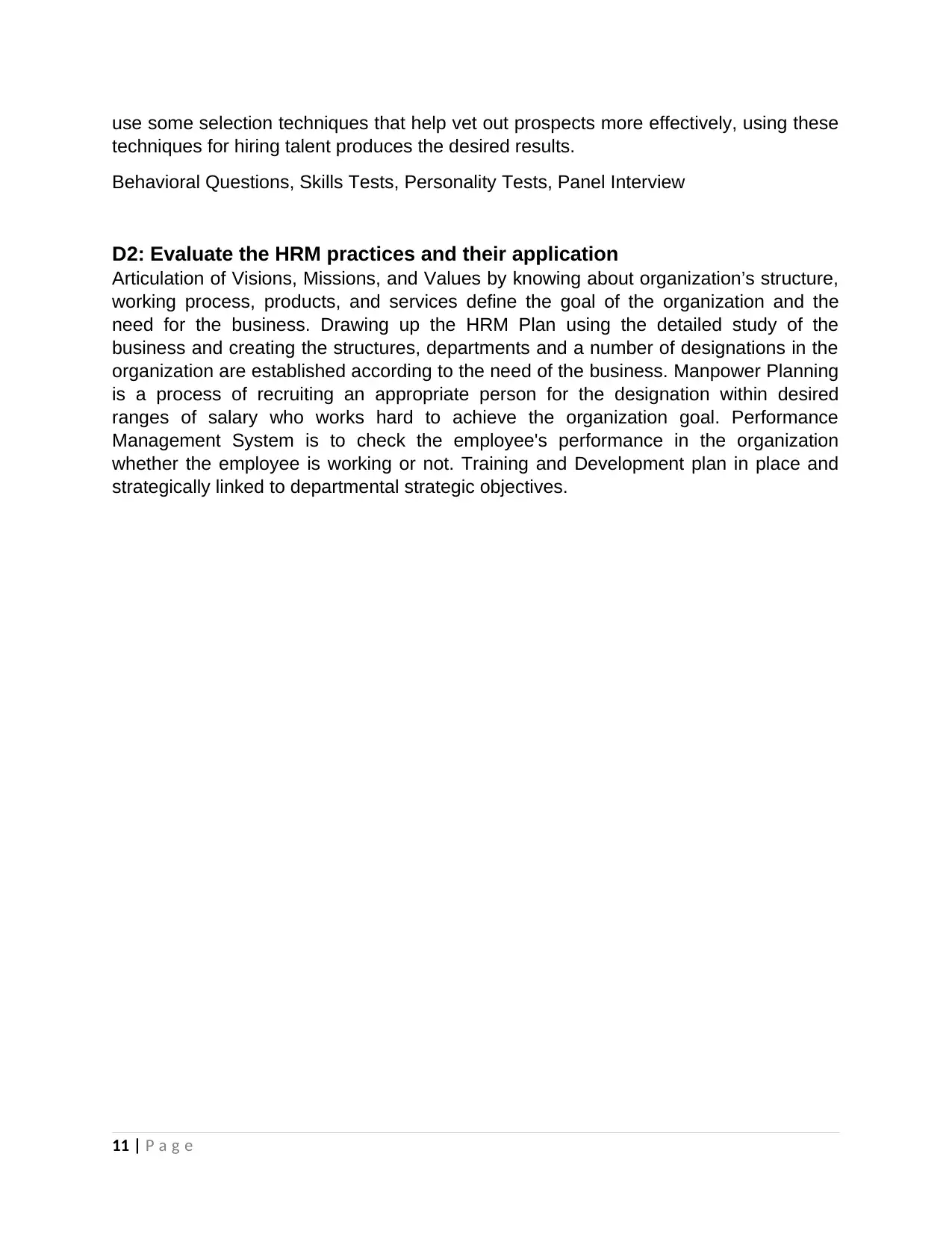
use some selection techniques that help vet out prospects more effectively, using these
techniques for hiring talent produces the desired results.
Behavioral Questions, Skills Tests, Personality Tests, Panel Interview
D2: Evaluate the HRM practices and their application
Articulation of Visions, Missions, and Values by knowing about organization’s structure,
working process, products, and services define the goal of the organization and the
need for the business. Drawing up the HRM Plan using the detailed study of the
business and creating the structures, departments and a number of designations in the
organization are established according to the need of the business. Manpower Planning
is a process of recruiting an appropriate person for the designation within desired
ranges of salary who works hard to achieve the organization goal. Performance
Management System is to check the employee's performance in the organization
whether the employee is working or not. Training and Development plan in place and
strategically linked to departmental strategic objectives.
11 | P a g e
techniques for hiring talent produces the desired results.
Behavioral Questions, Skills Tests, Personality Tests, Panel Interview
D2: Evaluate the HRM practices and their application
Articulation of Visions, Missions, and Values by knowing about organization’s structure,
working process, products, and services define the goal of the organization and the
need for the business. Drawing up the HRM Plan using the detailed study of the
business and creating the structures, departments and a number of designations in the
organization are established according to the need of the business. Manpower Planning
is a process of recruiting an appropriate person for the designation within desired
ranges of salary who works hard to achieve the organization goal. Performance
Management System is to check the employee's performance in the organization
whether the employee is working or not. Training and Development plan in place and
strategically linked to departmental strategic objectives.
11 | P a g e
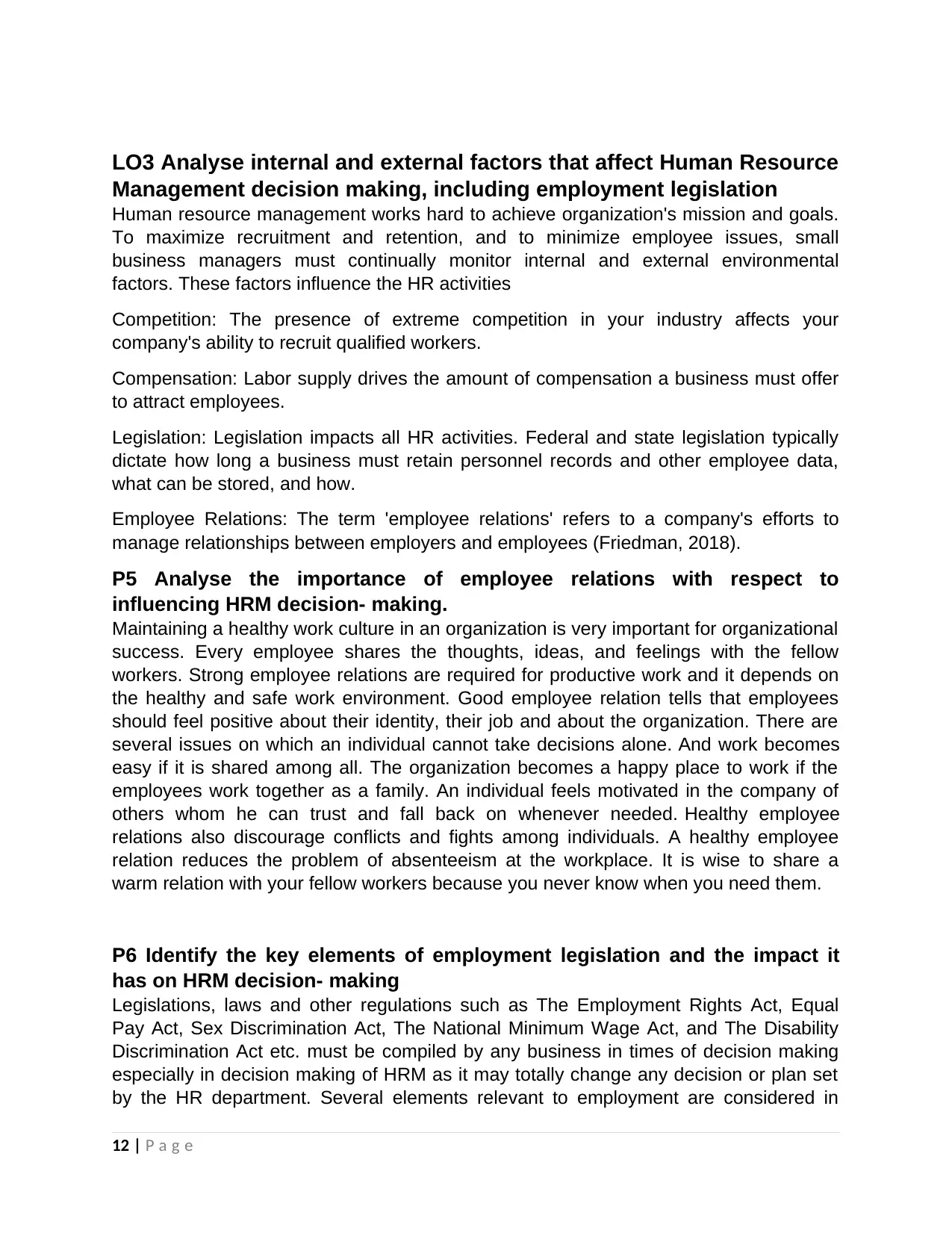
LO3 Analyse internal and external factors that affect Human Resource
Management decision making, including employment legislation
Human resource management works hard to achieve organization's mission and goals.
To maximize recruitment and retention, and to minimize employee issues, small
business managers must continually monitor internal and external environmental
factors. These factors influence the HR activities
Competition: The presence of extreme competition in your industry affects your
company's ability to recruit qualified workers.
Compensation: Labor supply drives the amount of compensation a business must offer
to attract employees.
Legislation: Legislation impacts all HR activities. Federal and state legislation typically
dictate how long a business must retain personnel records and other employee data,
what can be stored, and how.
Employee Relations: The term 'employee relations' refers to a company's efforts to
manage relationships between employers and employees (Friedman, 2018).
P5 Analyse the importance of employee relations with respect to
influencing HRM decision- making.
Maintaining a healthy work culture in an organization is very important for organizational
success. Every employee shares the thoughts, ideas, and feelings with the fellow
workers. Strong employee relations are required for productive work and it depends on
the healthy and safe work environment. Good employee relation tells that employees
should feel positive about their identity, their job and about the organization. There are
several issues on which an individual cannot take decisions alone. And work becomes
easy if it is shared among all. The organization becomes a happy place to work if the
employees work together as a family. An individual feels motivated in the company of
others whom he can trust and fall back on whenever needed. Healthy employee
relations also discourage conflicts and fights among individuals. A healthy employee
relation reduces the problem of absenteeism at the workplace. It is wise to share a
warm relation with your fellow workers because you never know when you need them.
P6 Identify the key elements of employment legislation and the impact it
has on HRM decision- making
Legislations, laws and other regulations such as The Employment Rights Act, Equal
Pay Act, Sex Discrimination Act, The National Minimum Wage Act, and The Disability
Discrimination Act etc. must be compiled by any business in times of decision making
especially in decision making of HRM as it may totally change any decision or plan set
by the HR department. Several elements relevant to employment are considered in
12 | P a g e
Management decision making, including employment legislation
Human resource management works hard to achieve organization's mission and goals.
To maximize recruitment and retention, and to minimize employee issues, small
business managers must continually monitor internal and external environmental
factors. These factors influence the HR activities
Competition: The presence of extreme competition in your industry affects your
company's ability to recruit qualified workers.
Compensation: Labor supply drives the amount of compensation a business must offer
to attract employees.
Legislation: Legislation impacts all HR activities. Federal and state legislation typically
dictate how long a business must retain personnel records and other employee data,
what can be stored, and how.
Employee Relations: The term 'employee relations' refers to a company's efforts to
manage relationships between employers and employees (Friedman, 2018).
P5 Analyse the importance of employee relations with respect to
influencing HRM decision- making.
Maintaining a healthy work culture in an organization is very important for organizational
success. Every employee shares the thoughts, ideas, and feelings with the fellow
workers. Strong employee relations are required for productive work and it depends on
the healthy and safe work environment. Good employee relation tells that employees
should feel positive about their identity, their job and about the organization. There are
several issues on which an individual cannot take decisions alone. And work becomes
easy if it is shared among all. The organization becomes a happy place to work if the
employees work together as a family. An individual feels motivated in the company of
others whom he can trust and fall back on whenever needed. Healthy employee
relations also discourage conflicts and fights among individuals. A healthy employee
relation reduces the problem of absenteeism at the workplace. It is wise to share a
warm relation with your fellow workers because you never know when you need them.
P6 Identify the key elements of employment legislation and the impact it
has on HRM decision- making
Legislations, laws and other regulations such as The Employment Rights Act, Equal
Pay Act, Sex Discrimination Act, The National Minimum Wage Act, and The Disability
Discrimination Act etc. must be compiled by any business in times of decision making
especially in decision making of HRM as it may totally change any decision or plan set
by the HR department. Several elements relevant to employment are considered in
12 | P a g e
⊘ This is a preview!⊘
Do you want full access?
Subscribe today to unlock all pages.

Trusted by 1+ million students worldwide
1 out of 15
Related Documents
Your All-in-One AI-Powered Toolkit for Academic Success.
+13062052269
info@desklib.com
Available 24*7 on WhatsApp / Email
![[object Object]](/_next/static/media/star-bottom.7253800d.svg)
Unlock your academic potential
Copyright © 2020–2025 A2Z Services. All Rights Reserved. Developed and managed by ZUCOL.



